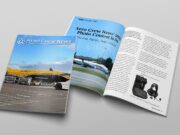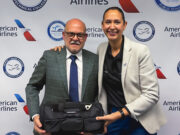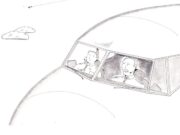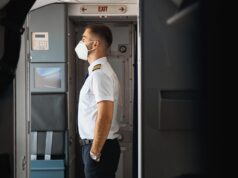
Year to date here in the Grey Matter column, we have focused on things happening directly or indirectly that affect your life on and off the line. This month, we are principally and literally talking about the lives of others.
There you are with great visibility and a smooth ride at cruise, ten-minutes ahead of schedule and sipping a coffee when the inter-cabin phone rings. You pick-up, thinking it a likely request to adjust the cabin temperature, but instead, the flight attendant on the other end says an older male passenger in seat 12A is pale, having difficulty breathing, and is clutching his chest. What should they do?
Have you ever chair-flown an in-flight medical emergency? Have you ever practiced contacting MedLink (or similar service contracted by your company), or even dispatch while airborne? If not, you should before you receive this call from the cabin.
So what do you do? Typically, the cabin crew is well trained to handle the initial situation and complete basic items such as providing the passenger in distress with supplemental on-board oxygen. Depending on specific airline policy, they will also probably begin quietly looking for qualified medical professionals among the other passengers and will have a few basic details to pass on to you such as seat number, age, gender, and general condition, along with medications and medical history if available and provided by the passenger or their travelling companion. You need to be ready to receive this information, and if the cabin crew seems not to immediately know what to do, you need to guide them to complete the basic items highlighted above: oxygen, professional medical assistance, basic passenger details.
Next, based on your aircraft’s capabilities, contact dispatch and relay the situation to them, and based on your company’s policies, request a radio patch to MedLink (or other remote medical consultant), providing them with passenger information for assessment. Be prepared to copy their instructions and pass these on to the cabin crew.
MedLink is in the unique position of not only assessing the passenger’s condition and knowing what specific medical equipment is on board your aircraft, but of advising for continuing to the scheduled destination or diverting to a specific alternate based on time, type of medical situation, and the medical facilities required to adequately assist the passenger. Airlines with a MedLink contract strongly encourage flight crews to follow their guidance for in-cabin treatment, as well as continuing or diverting – with the caveat that the final authority as to the safe operation of the flight remaining with the captain.
Side note: Regarding captain’s authority and recommendations from MedLink, they are exactly that, authority vs. recommendation. The captain must consider all factors including safety, security, and the physical as well as emotional well-being of the crew and passengers when making a final determination as to the conduct of the flight. MedLink, whose role is to provide expert medical advice and support, is a part of the captain’s decision-making toolbox, but is also an efficiency device contracted by the airline to prevent “unnecessary” diversions. MedLink is a great tool, but just like ATC or dispatch, do not let a remote entity fly your plane – make the best decision possible with the all the information available and with your eyes directly from the flight deck.
A few other important and practical things to remember. First and foremost, fly the plane. Ensure one member of the flight crew is designated to interact with cabin crew, dispatch, and MedLink, etc., while the other pilot exclusively manages the aircraft and the radios. Second, DO NOT, under any circumstances, leave the flight deck to assist with the situation. Although unlikely that the medical emergency is a ruse to get the flight deck door open, it is best to suspend opening it until the situation is under control. Third, should you elect to divert, declare an emergency with ATC. If you determine or if the medical specialist advising you has indicated that time is of the essence, utilize ATC to meet this objective through priority handling and even relief from 250kts below 10,000ft. should the situation call for it. Use emergency authority effectively, though safely. Lastly, keep a record of the incident because you will need to file a report after landing.
Next, let us imagine a similarly nice day for flying, when you look over at your flying partner to ask their opinion on the recent company announcement about adding new routes only to find them slumped to the side and unresponsive. It is one thing to have a passenger in the back suffering from a massive coronary event or stroke; it is quite another kind of unsettling to have it be the pilot sitting next to you.
So again, what do you do? Literally, start by calling for help. Contact ATC, declare an emergency now and have them standby. Next, call the cabin crew to help you get the incapacitated pilot away from the flight controls – but DO NOT leave your seat in order to do so. If possible, slide their seat back and then calmly inform the flight attendants of the situation and the need to help you secure the pilot. Follow flight deck door opening procedures as closely as allowable under the circumstances, and have the cabin crew remove the pilot from the seat and to the nearest galley or open cabin seat for medical assistance if possible. If not, consider moving them to the flight deck jumpseat with seatbelt and shoulder straps securely in place.
If there is another company pilot on board (a non-rev or deadheader) get them into the flight deck with you and direct them to take the unoccupied seat and frankly, not to touch anything. Remain in the seat you are qualified in, quickly assess the other pilot’s qualifications, assign flight deck tasks, and then build a plan – always fly the plane first. In the event there is no other qualified air transport pilot on board, and using emergency authority, consider having a flight attendant remain in the flight deck with you in order to coordinate with the cabin crew as necessary and look after the incapacitated pilot if strapped into the flight deck jumpseat.
At this point and as time allows, let dispatch know, contact MedLink, decide whether to divert or continue, and execute the plan. Check back in with ATC and go from there.
Side note: Declaring an emergency with ATC early in this situation provides several benefits including not having to worry about routine communications when you are trying to manage a serious situation; moreover, you get priority handling, a dedicated controller to assist you, and any resources you need to get to an alternate or the planned destination as quickly as possible once that decision is made.
It is almost guaranteed that you will face an in-flight emergency during the course of your aviation career. With any luck though, you will not have to experience the trauma of losing your flying partner mid-flight. Yet, should these happen to you at any point, be ready, know what your company manual recommends and requires in these situations, and as with any emergency, chair-fly and plan ahead.
Stay healthy and we will see you next month for more disaster and disruption on the road.

















































